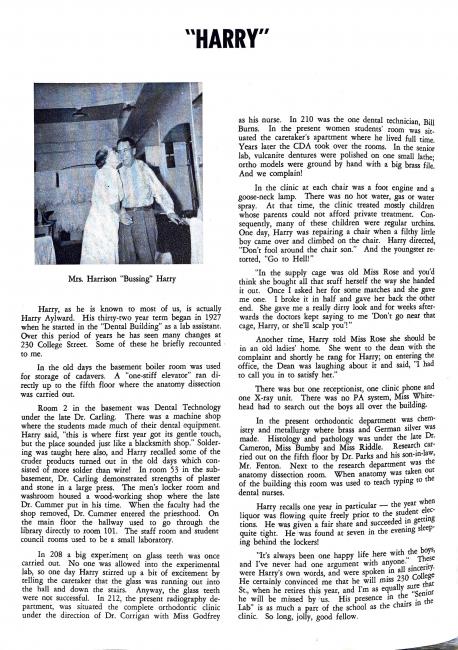"HARRY"
Harry, as he is known to most of us, is actually Harry Aylward. His thirty-two year term began in 1927 when he started in the "Dental Building" as a lab assistant. Over this period of years he has seen many changes at 230 College Street. Some of these he briefly recounted to me.
In the old days the basement boiler room was used for storage of cadavers. A "one-stiff elevator" ran di rectly up to the fifth floor where the anatomy dissection was carried out.
Room 2 in the basement was Dental Technology under the late Dr. Carling. There was a machine shop where the students made much of their dental equipment. Harry said, "this is where first year got its gentle touch, but the place sounded just like a blacksmith shop." Solder ing was taught here also, and Harry recalled some of the cruder products turned out in the old days which con sisted of more solder than wire! In room 53 in the sub basement, Dr. Carling demonstrated strengths of plaster and stone in a large press. The men's locker room and washroom housed a wood-working shop where the late Dr. Cummer put in his time. When the faculty had the shop removed, Dr. Cummer entered the priesthood. On the main floor the hallway used to go through the library directly to room 101. The staff room and student council rooms used to be a small laboratory.
In 208 a big experiment on glass teeth was once carried out. No one was allowed into the experimental lab, so one day Harry stirred up a bit of excitement by telling the caretaker that the glass was running out into the hall and down the stairs. Anyway, the glass teeth were not successful. In 212, the present radiography de partment, was situated the complete orthodontic clinic under the direction of Dr. Corrigan with Miss Godfrey as his nurse. In 210 was the one dental technician, Bill Burns. In the present women students room was sit uated the caretaker's apartment where he lived full time. Years later the CDA took over the rooms. In the senior lab, vulcanite dentures were polished on one small lathe; ortho models were ground by hand with a big brass file. And we complain!
In the clinic at each chair was a foot engine and a goose-neck lamp. There was hot water, gas or water spray. At that time, the clinic treated mostly children whose parents could not afford private treatment. Con sequently, many of these children were regular urchins. One day, Harry was repairing a chair when a filthy little boy came over and climbed on the chair. Harry directed, "Don't fool around the chair son." And the youngster re- torted, "Go to Hell!"
"In the supply cage was old Miss Rose and you'd think she bought all that stuff herself the way she handed it out. Once I asked her for some matches and she gave me one. I broke it in half and gave her back the other end. She gave me a really dirty look and for weeks after wards the doctors kept saying to me 'Don't go near that cage, Harry, or she'll scalp you!"
Another time, Harry told Miss Rose she should be in an old ladies' home. She went to the dean with the complaint and shortly he rang for Harry, on entering the office, the Dean was laughing about it and said, "I had to call you in to satisfy her."
There was but one receptionist, one clinic phone and one X-ray unit. There was no PA system, Miss White head had to search out the boys all over the building.
In the present orthodontic department was chem istry and metallurgy where brass and German silver was made. Histology and pathology was under the late Dr. Cameron, Miss Bumby and Miss Riddle. Research car ried out on the fifth floor by Dr. Parks and his son-in-law, Mr. Fenton. Next to the research department was the anatomy dissection room. When anatomy was taken out of the building this room was used to teach typing to the dental nurses.
Harry recalls one year in particular - the year when liquor was flowing quite freely prior to the student elec tions. He was given a fair share and succeeded in getting quite tight. He was found at seven in the evening sleep ing behind the lockers!
"It's always been one happy life here with the boys, and I've never had one argument with anyone." These were Harry's own words, and were spoken in all sincerity. He certainly convinced me that he will miss 230 College St., when he retires this year, and I'm as equally sure that he will be missed by us. His presence in the "Senior Lab" is as much a part of the school as the chairs in the clinic. So long, jolly, good fellow.
Mrs. Harrison "Bussing" Harry
